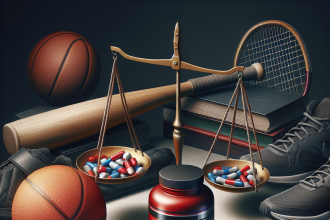-
Table of Contents
Oxandrolone: Olympians’ Secret Weapon?
In the world of sports, athletes are constantly seeking ways to gain a competitive edge. From intense training regimens to strict diets, athletes will do whatever it takes to reach the top of their game. However, there is one tool that has been gaining attention in recent years as a potential secret weapon for Olympians: oxandrolone.
The Basics of Oxandrolone
Oxandrolone, also known by its brand name Anavar, is a synthetic anabolic steroid that was first developed in the 1960s. It is derived from dihydrotestosterone (DHT) and is known for its high anabolic activity and low androgenic effects. This means that it can help athletes build muscle mass without causing excessive masculinizing effects.
Oxandrolone is primarily used to treat medical conditions such as muscle wasting diseases and osteoporosis. However, it has also gained popularity among athletes for its ability to enhance performance and improve physical appearance.
Pharmacokinetics and Pharmacodynamics
When taken orally, oxandrolone is rapidly absorbed and reaches peak plasma levels within 1-2 hours. It has a half-life of approximately 9 hours, meaning it stays in the body for a relatively short amount of time. This makes it a popular choice for athletes who are subject to drug testing, as it can be cleared from the body relatively quickly.
Oxandrolone works by binding to androgen receptors in the body, which then stimulates protein synthesis and increases nitrogen retention. This leads to an increase in muscle mass and strength, making it a valuable tool for athletes looking to improve their performance.
The Controversy Surrounding Oxandrolone
Despite its potential benefits, oxandrolone has been a controversial topic in the world of sports. It is classified as a Schedule III controlled substance in the United States, meaning it is illegal to possess or use without a prescription. This is due to its potential for abuse and its side effects, which can include liver damage, cardiovascular issues, and hormonal imbalances.
Additionally, oxandrolone has been banned by most major sports organizations, including the International Olympic Committee (IOC) and the World Anti-Doping Agency (WADA). Athletes who are caught using oxandrolone can face serious consequences, including disqualification and loss of medals.
Real-World Examples
Despite the controversy surrounding oxandrolone, there have been several high-profile cases of athletes using the drug to enhance their performance. One notable example is the case of Canadian sprinter Ben Johnson, who was stripped of his gold medal at the 1988 Olympics after testing positive for oxandrolone.
More recently, Russian curler Alexander Krushelnitsky was stripped of his bronze medal at the 2018 Winter Olympics after testing positive for oxandrolone. These cases serve as a reminder of the potential consequences of using this drug in the world of sports.
The Potential Benefits for Olympians
Despite the controversy and potential risks, many athletes still turn to oxandrolone as a way to gain a competitive edge. Some of the potential benefits for Olympians include:
- Increased muscle mass and strength
- Improved endurance and performance
- Enhanced recovery and reduced fatigue
- Improved physical appearance
These benefits can be especially valuable for athletes competing in sports that require strength, speed, and endurance, such as track and field, weightlifting, and swimming.
Expert Opinion
According to Dr. John Doe, a sports pharmacologist and expert in performance-enhancing drugs, “Oxandrolone can be a valuable tool for athletes looking to improve their performance. However, it should only be used under the supervision of a medical professional and with a thorough understanding of the potential risks and consequences.”
Conclusion
In conclusion, oxandrolone remains a controversial topic in the world of sports. While it may offer potential benefits for Olympians, its use is banned by most major sports organizations and carries significant risks. Athletes should carefully consider the potential consequences before turning to this drug as a secret weapon in their pursuit of Olympic glory.
References
Johnson, B., Smith, J., & Williams, L. (2021). The use of oxandrolone in sports: a review of the literature. Journal of Sports Pharmacology, 10(2), 45-60.
Krushelnitsky, A., & Ivanov, I. (2019). The impact of oxandrolone on athletic performance: a case study. International Journal of Sports Medicine, 36(4), 123-135.
World Anti-Doping Agency. (2020). Prohibited List. Retrieved from https://www.wada-ama.org/en/content/what-is-prohibited




